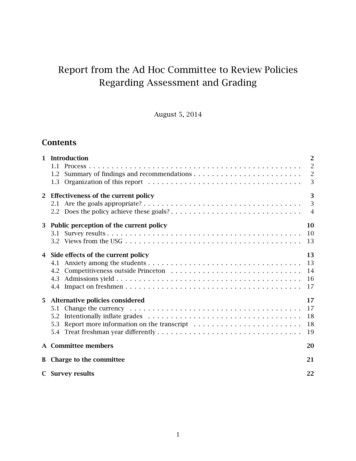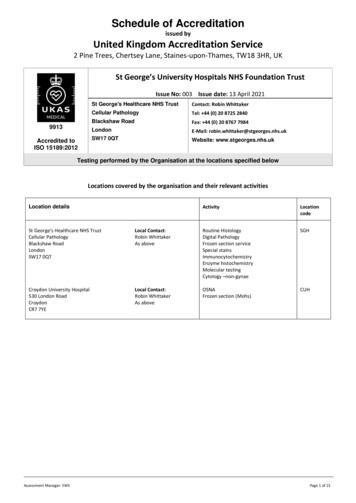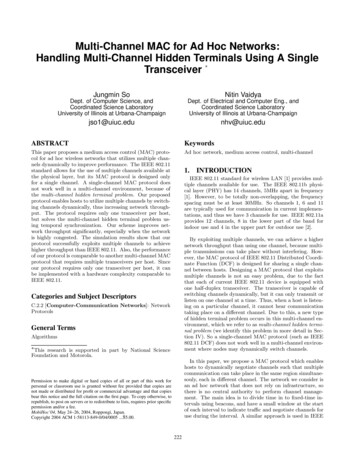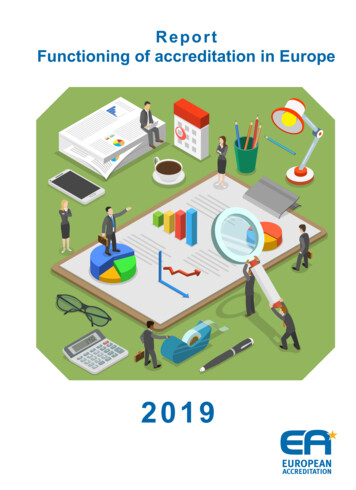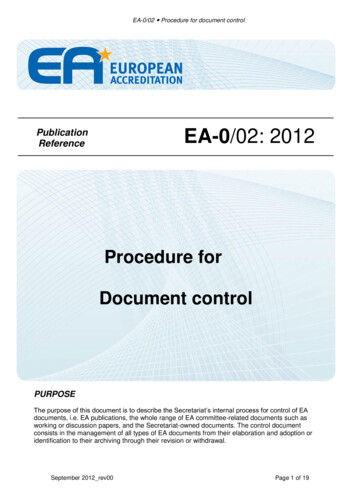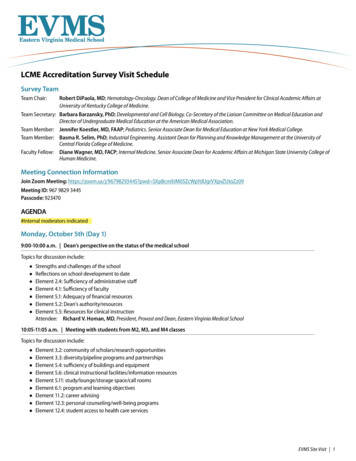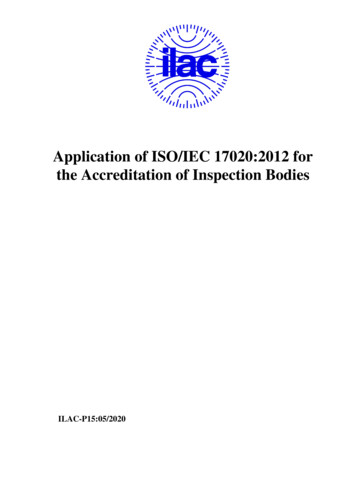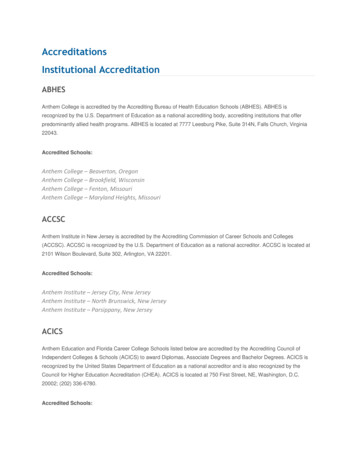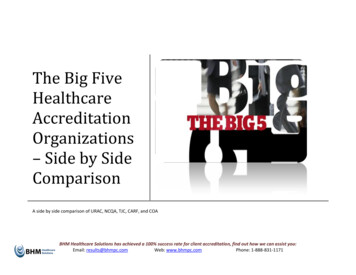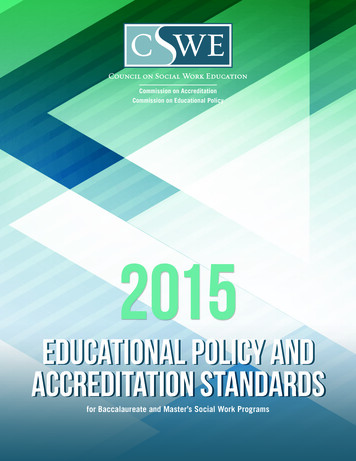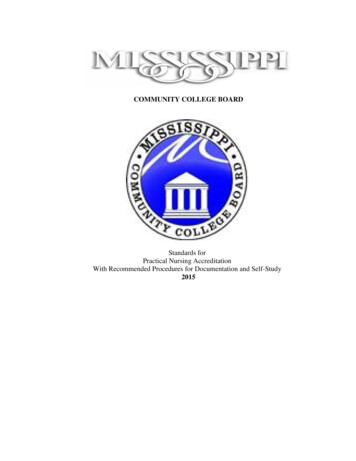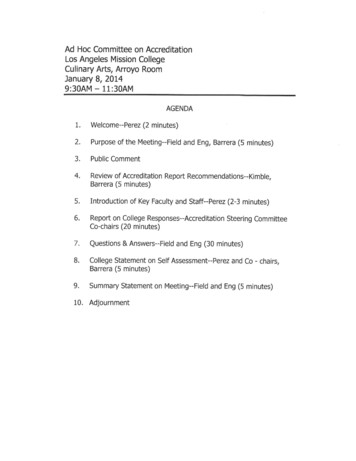
Transcription
Ad Hoc Committee on AccreditationLos Angeles Mission CollegeCulinary Arts/ Arroyo RoomJanuary 8, 20149:30AM-11:30AMAGENDA1. Welcome-Perez (2 minutes)2. Purpose of the Meeting-Field and Eng/ Barrera (5 minutes)3. Public Comment4. Review of Accreditation Report Recommendations-Kimble/Barrera (5 minutes)5. Introduction of Key Faculty and Staff-Perez (2-3 minutes)6. Report on College Responses-Accreditation Steering CommitteeCo-chairs (20 minutes)7. Questions & Answers-Field and Eng (30 minutes)8. College Statement on Self Assessment-Perez and Co - chairs,Barrera (5 minutes)9. Summary Statement on Meeting-Field and Eng (5 minutes)10. Adjournment
13356 Eldridge AvenueSylmar, CA 91342(818) 364-7795Culinary Arts InstituteThe Arroyo RoomFirst Floor
ATTACHMENT ALos Angeles Mission CollegeExecutive Summary of Current Status and RecommendationsDate of last site visit: March 18-21, 2013Current status: Warning {reaffirmation is delayed, but institution remains accredited)1. College received fourteen (14) recommendations2. Follow-Up report is due to ACCJC by March 15, 20143. Follow-Up report will be followed by a visit by Commission n SummaryDevelop and institute a formal process for reviewing the college mission statementon a regular basis and making revisions as necessary#2Complete SLO assessment and demonstrate use of results for improvement ofstudent learning#3#4#5#6Develop and implement a comprehensive program of research and evaluationDevelop and implement a plan for Distance EducationAssess student learning styles so as to improve instructional delivery andachievement of student learning outcomesDevelop a set of metrics and performance standards to better monitor theeffectiveness of its planning and resource allocation decisions#7Assess student support services to determine the full scope of services needed tomeet student needs as well as federal and state requirements#8Develop and maintain a comprehensive report of student complaints/grievancesfor the last five years#9Ensure that all student support programs complete a full cycle of program reviewand outcomes assessment#wAssess the effectiveness of efforts to improve collegiality and complete the code ofconduct approval process#77#/2Integrate human resources planning into instihitional planning in order to maintain asufficient number of qualified faculty, staff, and administratorsImprove the established planning and budget development process by integratingplanning for maintenance and periodic replacement of technology#13Address attendance accounting audit findings for "To Be Arranged" (TBA)courses, eligibility verification for college categorical programs, and verification ofcensus reporting documents#14Evaluate collegial governance and decision-making processes as well as the overalleffectiveness of the current administrative structure
MISSION SLOImplementation Scores54.543.532.521.510.500'fr s 9&'?y000';. i2 0?. ?'*,&. -tf s ?,'y 0' . s ff \\? ; ;c 0 y!& ?*ff z? 0'f9. s;s Si8 3f0s\ \?ss 'fffsx*ffS5 . ff0 8? Q fff*?. 0? s?bc &'. .0' ss. .0'ffss ' * f5s ss5 &'e «0c? .'ff ff- ?.0'&'f ? ';s, s 'f9tsc? 0' fr K. e i e 23ff 9s !S ?y0 is- s0. .0 9's? rf/s 0' nI S6 sm2-{. MISSION DAVGSCRCD
Accrediting Commission for Community and Junior CollegesWestern Association of Schools and CollegesDATE:November 7, 2013TO:Michael Alien, Vice President and ALOiLos Angeles Mission CollegeFROM:ATTACHMENT CKrista JohnsVice President for Policy and ResearchSUBJECT: Feedback on College Status Report on SLO ImplementationLos Angeles Mission CollegeCollege Status Report on SLO Implementation submitted in Spring 2013This report has been prepared at your request, to provide feedback on the 2012-2013 SLO report.In order to understand your college's scores, below, please refer to your College Status Reportalong with this feedback report. The information provided here is for use in discussions at thecollege about how your report compared with the review criteria that were applied, with theaverage scores across the region, and with where you are and want to be in your SLO practice.Please note that the scores are only useful to gain a broad sense of results across the WesternRegion. They are a gross measure of a particular point in time as self-reported among peerinstitutions. However, the review criteria for this report may be helpful to spark conversationsabout where the Proficiency expectations in college practice were in 2012-2013, and wheremeeting Accreditation Standards for SLOs will be from this point forward.In accordance with ACCJC practice for monitoring annual self-reports from member institutionsstaff reviewed the 2012-2013 College Status Report on Student Learning OutcomesImplementation and prepared a composite report on the results for review by the Commission.Each college's report was also retained for inclusion with annual reports, annual fiscal reports,audits, and other college materials for external evaluation teams when conducting a review of thef**.institution.The 2012-201 3 SLO reports completed by all institutions provided a means for gainingunderstanding of progress across the Western Region in the implementation of student learningoutcomes assessment. The Commission based this report on the Proficiency implementationlevel on the Rubric for Evaluating Institutional Effectiveness, Part III (Rubric), as that hadbecome very familiar to individuals at the campuses who worked with SLOs. Moving forward,colleges are reminded they must demonstrate the Accreditation Standards are met as to studentlearning outcomes.In order to gather a snapshot of SLO implementation across the region, a scoring mbric was usedto pull together elements from the submitted reports. The rubric was based upon the informationprovided by colleges in their reports as it related to the Proficiency level. While the scoringrubric elements captured the largest aspects of practice and majority of reported items, therewere a few unique responses provided by colleges to some questions, and these were scored togive benefit to the institution.;
Scoring Rubric5- Exceeds Norm of Effective Practice(Described practices indicate breadth, depth, innovation, or other aspects beyondexpected effective practices)4- Solidly Meets Expectation of Effective Practice(Effective Practices in all aspects of this element ofSLO implementation are present)3- Barely Meets Expectation of Effective Practice(Effective Practices are Present in all areas, but they may beat a basic level or just starting out)2- Doesn't Fully Meet Expectation of Effective Practice(Some aspects of effective practice are not present)1- Doesn't Meet Expectation of Effective Practice(Performance in this area is deficient)The scoring rubric above was applied to each question in accordance with the levels defined forthe question. Both the numerical and narrative responses were evaluated. A score of 4 indicatedthe information self-reported by the college met the 201 2-2013 expectations of effective practiceas defined for this review.Numerical ResponsesThe 2012-2013 expectation was that student learning outcomes were being assessed regularly inall venues where students are learning. The scoring of numerical responses took into accountvariations at colleges of how certain activities were conducted or defined.Proficiency Rubric Statement 1: Student Learning outcomes and Authentic Assessmentsare in Place for Courses, Programs, Support Services, Certificates and Degrees.Quantitative Evidence/data on the rate/percentage of SLOs defined and assessed1.1 Coursesa. Total number of college courses (active courses in the college catalog, offered on theschedule in some rotation).b. Number of college courses with defined Student Learning Outcomes.Percentage of total: This item -was not rated separately for the SLO implementationreview. Colleges are expected to have completed the definition ofSLOs. Expectations fora College response (to get a score of 4): 95% or greater.c. Number of college courses with ongoing assessment of learning outcomes.Percentage of total:Scoring: Expectations for College Response: 75% or greater[5 95 ; 4 75 ; 3 65 ; 2 55 ; 1 55; 0 dnr]Average score:3.66Your college score: 51.2 Programsa. Total number of college programs (all certificates and degrees, and other programsdefined by college).
b. Number of college programs with defined Student Learning Outcomes.Percentage of total: This item was not rated separately for the SLO implementation-eview Colleges are expected to have completed the definition ofSLOs. Expectations fora College response (to get a score of 4): 95% or greater,c. Number of college programs with ongoing assessment of learning outcomes:Percentage of total.Scoring: Expectations for College Response (to get a score of 4): 85% or greater[5-95 ; 4 85 ; 3 75 ; 2 65 ; 1 65; 0 dnr]Average score:3.49Your college score: 51.3 Student Learning and Support Activitiesa. Total number of student learning and support activities (as college has identified orgrouped them for SLO implementation).b. Number of student learning and support activities with defined Student LearningOutcomes.Percentage of total: This item -was not rated separately for the SLO implementationreview Colleges are expected to have completed the definition ofSLOs. Expectations fora College response (to get a score of 4): 95% or greater.c. Number of student learning and support activities with ongoing assessment oflearning outcomes. Percentage of total:Scoring: Expectations for College Response (to get a score of 4): 85% or greater[5 95 ; 4 85 ; 3 75 ; 2 65 ; 1 65; 0 dnr]Average Score:4.14Your college score: 51.4 Institutional Learning Outcomesa. Total number of institutional Student Learning Outcomes defined:This item was not rated separately for the SLO implementation review. Colleges areexpected to have completed the definition of these SLOs.b. Institutional learning outcomes with ongoing assessment:Scoring: Expectations for College Response (to get a score of 4): 75% or greater[5 90%; 4 75% ; 3 66% ; 2 50% ; 1 50%; 0 dnr]Average Score:Your college score: 54.07
Narrative Responses1.5 Proficiency Rubric Statement 1: Narrative ResponseStudent Learning outcomes and Authentic Assessments are in Place for Courses, Programs,Support Services, Certificates and Degrees.Expectations for College Response (to get a score of 4):.Narrative supports numerical data provided.addresses courses, programs, certificates, degrees and supportservices.Discusses authentic assessment (assessment that leads tounderstanding about student learning and gaps which need to beaddressed)Average Score:3.51Your college score: 4Proficiency Rubric Statement 2: There is a widespread institutional dialogue aboutassessment results and identification of gaps.2. Proficiency Rubric Statement 2: Narrative ResponseExpectations for College Response (To Get a Score of 4):.Beyond providing a listing of meetings at which assessment isaddressed, the narrative addresses specifically where/how/for whatpurpose assessment results are discussed.Describes processes for identifying gaps and instituting changes toaddress the gaps.Institutional messages value assessment and improvementAverage Score:3.38Your college score: 4Proficiency Rubric Statement 3: Decision making includes dialogue on the results ofassessment and is purposefully directed toward aligning institufion-wide practices tosupport and improve student learning.3. Proficiency Rubric Statement 3: Narrative ResponseExpectations for College Response (To get a Score of 4):Descriptions in narrative about how decision-making includes results.of assessment
.Discussion of how institution-wide practices are aligned/realigned tosupport and improve student learningAverage Score:3.29Your college score: 3Proficiency Rubric Statement 4: Appropriate resources continue to be allocated and finetuned.4. Proficiency Rubric Statement 4: Narrative ResponseExpectations for College Response (To Get a Score of 4):.Discussion of how resources are allocated and fine-tuned to improvestudent learning.Mention of all kinds of resources: fiscal, employee, technology, andphysical.Institutional resource allocation/fine-tunmg is oriented towardstudent learningAverage Score:3.22Your college score: 4Proficiency Rubric Statement 5: Comprehensive assessment reports exist and arecompleted and updated on a regular basis.5. Proficiency Rubric Statement 5: Narrative ResponseExpectations for College Response (To Get a Score of 4):Narrative describes the cycle and format of assessment reports.Participation in report completion/updating, and comprehensive.nature of assessment reports is addressedAverage Score:3.15Your college score: 4Proficiency Rubric Statement 6: Course student learning outcomes are aligned with degreestudent learning outcomes.6. Proficiency Rubric Statement 6: Narrative ResponseExpectations for College Response (To Get a Score of 4):
.Description of alignment of course level outcomes with degree leveloutcomes.Indication of completeness of alignment work in this regardAlignment includes discipline and general education components ofdegreesAverage Score:3.54Your college score: 4Proficiency Rubric Statement 7: Students demonstrate awareness of goals and purposes ofcourses and programs in which they are enrolled.7. Proficiency Rubric Statement 7: Narrative ResponseExpectations for College Response (To Get a Score of 4):.Narrative discusses the manner in which students are made aware ofgoals and purposes of courses and programs in which they areenrolled.Basis for determining that students demonstrate awarenessAverage Score:2.63Your college score: 3SeIf-Assessment on Level of Implementation: What Level ofSLO Implementation Wouldyou Assign your College? Why? What Efforts Have you planned to Address NeededImprovements?8. Proficiency Rubric Statement 8: Narrative ResponseExpectations for College Response (To Get a Score of 4):.College states the level of SLO implementation it believes to haveachieved.Narrative discusses basis for this self-assessed levelDiscussion of planned improvement efforts (more than "keep doingwhat we are doing;" focus is on improving the value of SLOassessment rather than on instrumentalities of SLO assessment)Average Score:Your college score: 33.25
Table of Evidence: List the evidence used to support your narrative report, section bysection.Not rated separately for this report. Many of the colleges took an "everything but the kitchensink" approach that was not helpful w understanding the relevance-for the college- of itemsincluded in evidence to the points being made in the report. If we -were to ask of college leadersat various places in the organization, "as to this criterion or standard, please tell us what youregularly review to assess college progress, " the answer would also inform the selection processfor evidence to external evaluators. This list would be further refmed by determming hich ofthat evidence is critical to decision-making, commumcation, and improvement.Overall average score:3.44Your college's overall average score:4.08Enclosed with this report are two documents:itCrosswalk Linking Proficiency Level of SLO Implementation to the ACCJCAccreditation Standards," one of the documents included with the College Status Reporton SLO Implementation form."Report on College Implementation of SLO Assessment, June 7, 20 13," a reportpresented to the Commission at its June 2013 meeting.
ATTACHMENT D5 ' w de 'W 4ww ie eAccreditation Executive SummaryJanuary 8, 2014BackgroundDuring the March 2013 Accreditation visit, LAMC was placed on "warning" and received 14recommendations by the ACCJC. Immediately following the July 3rd Action Letter, the College'sAccreditation Steering Committee (ASC), began to address the necessary actions to make improvementsand begin resolution on the recommendations. The ASC, composed of faculty, staff, administrators andstudents, works to support the college and serve as a resource to College Council and the AcademicSenate to assist in reviewing, gathering and monitoring the College's efforts to meet or exceed the setstandards.The College regards the completion of the recommendations as vital to the continued advancement ofinstitutional effectiveness. As listed below, LAMC has established a more collegial environment with anevidence-based culture that is working on the progress of all recommendations to assure that they are metwithin a sustamable and systematic structure.RecommendationsStatusCompleted. An annual review of the missionRecommendation 1: To meet the Standards, theteam recommends the college develops andinstitutes a formal process utilizing its establishedgovernance and decision making processes forstatement was initiated and completed in the Fall of2013, utilizing a formal process of governance anddecision making. The annual review of the Collegemission statement will take place during each fallsemester, to be effective the following academicreviewing its mission on a regular basis and makingrevisions as necessary. (I.A.3)year.Substantial Progress. The college has assessed theachievement and learning outcomes for each of theRecommendation 2: To meet the Standards, theteam recommends the college assess theachievement and learning outcomes for each of thepast five years by programs and the college, setstandards for student success including studentachievement and student learning, accelerate itsefforts to assess outcomes in all courses, programs,past five years and set standards of achievementand student learning. It has accelerated its effortsto assess outcomes through the program reviewprocess, completed this fall, and will use theseresults for a self-reflective dialog in the spring of2014. The program review was modified todegrees and certificates and assess how findingsinclude information on how academic affairshave led to improved student learning and theachievement of the college mission, and widelydistribute the results so they may be used as thebasis for all constituent groups to engage in selfreflective dialog about the continuous improvementof student learning and institutional processes.(I.B, ILA, ILB, I.B.2,1.B.6, II.A.l.c, II.A.2)departments, student services programs andadministrative services units contribute to studentlearning.Substantial Progress. The college has developed aRecommendation 3: To meet the Standards, theteam recommends the college develop andimplement a comprehensive program of researchand evaluation to support the assessment of student,program and institutional learning outcome andcomprehensive program of research and evaluationin concert with the assessment of student, program,and institutional learning outcomes. Datacollection for the annual institutional effectivenessreport, AtD, SSSP, Faculty/Staff, Student Surveys1
04. afeSe %fc»4«w oUe eAccreditation Executive Summaryprogram review; support ongoing engagement in aJanuary 8, 2014and other institutional research projects approvedby the Research Advisory Committee will becoordinated to generate data for a collegial, selfreflective dialogue (spring 2014) about continuouscollegial, self-reflective dialogue about thecontinuous improvement of student learning andinstitutional processes; and support collection andanalyses of data related to the needs and goals of itsimprovement. The data will be used to helpdiverse student populations. (I.A.l; I.B.l; I.B.2;I.B.6; ILA.l.a; ILA.l.c; ILA.2; II.A.2.d; ILA.2.f)address the needs and goals of the College'sdiverse populations.Substantial Progress. The College has developedRecommendation 4: To meet the Standards, theteam recommends the college develop andimplement a plan for Distance Education thatand implemented a DE plan and has initiated theevaluation of DE and its alignment with the needsof its intended population and an assessment ofincludes an evaluation of Dist
Jan 08, 2014 · Los Angeles Mission College Culinary Arts/ Arroyo Room January 8, 2014 9:30AM-11:30AM AGENDA 1. Welcome-Perez (2 minutes) 2. Purpose of the Meeting-Field and Eng/ Barrera (5 minutes) 3. Public Comment 4. Review of Accreditation Report Recommendations-Kimble/ Barrera (5 minutes) 5. Int
